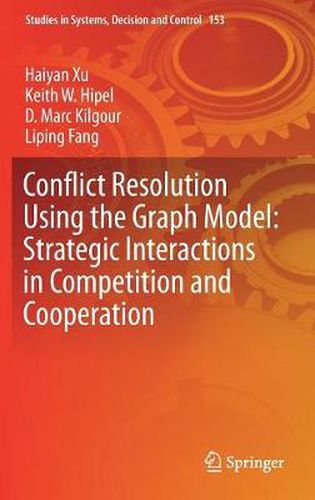Readings Newsletter
Become a Readings Member to make your shopping experience even easier.
Sign in or sign up for free!
You’re not far away from qualifying for FREE standard shipping within Australia
You’ve qualified for FREE standard shipping within Australia
The cart is loading…






This title is printed to order. This book may have been self-published. If so, we cannot guarantee the quality of the content. In the main most books will have gone through the editing process however some may not. We therefore suggest that you be aware of this before ordering this book. If in doubt check either the author or publisher’s details as we are unable to accept any returns unless they are faulty. Please contact us if you have any questions.
This cutting-edge book presents the theory and practice of the Graph Model for Conflict Resolution (GMCR), which is used for strategically investigating disputes in any field to enable informed decision making. It clearly explains how GMCR can determine what is the best a particular decision maker (DM) can independently achieve in dynamic interaction with others. Moves and counter-moves follow various stability definitions reflecting human behavior under conflict. The book defines a wide range of preference structures to represent a DM’s comparisons of states or scenarios: equally preferred, more or less preferred; unknown; degrees of strength of preference; and hybrid. It vividly describes how GMCR can ascertain whether a DM can fare even better by cooperating with others in a coalition. The book portrays how a conflict can evolve from the status quo to a desirable resolution, and provides a universal design for a decision support system to implement the innovative decision technologies using the matrix formulation of GMCR. Further, it illustrates the key ideas using real-world conflicts and supplies problems at the end of each chapter. As such, this highly instructive book benefits teachers, mentors, students and practitioners in any area where conflict arises.
$9.00 standard shipping within Australia
FREE standard shipping within Australia for orders over $100.00
Express & International shipping calculated at checkout
This title is printed to order. This book may have been self-published. If so, we cannot guarantee the quality of the content. In the main most books will have gone through the editing process however some may not. We therefore suggest that you be aware of this before ordering this book. If in doubt check either the author or publisher’s details as we are unable to accept any returns unless they are faulty. Please contact us if you have any questions.
This cutting-edge book presents the theory and practice of the Graph Model for Conflict Resolution (GMCR), which is used for strategically investigating disputes in any field to enable informed decision making. It clearly explains how GMCR can determine what is the best a particular decision maker (DM) can independently achieve in dynamic interaction with others. Moves and counter-moves follow various stability definitions reflecting human behavior under conflict. The book defines a wide range of preference structures to represent a DM’s comparisons of states or scenarios: equally preferred, more or less preferred; unknown; degrees of strength of preference; and hybrid. It vividly describes how GMCR can ascertain whether a DM can fare even better by cooperating with others in a coalition. The book portrays how a conflict can evolve from the status quo to a desirable resolution, and provides a universal design for a decision support system to implement the innovative decision technologies using the matrix formulation of GMCR. Further, it illustrates the key ideas using real-world conflicts and supplies problems at the end of each chapter. As such, this highly instructive book benefits teachers, mentors, students and practitioners in any area where conflict arises.